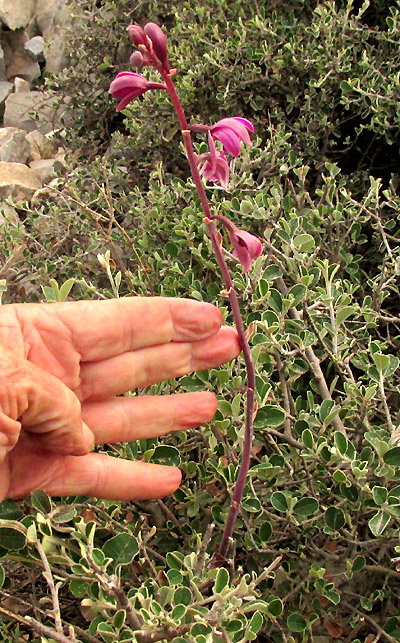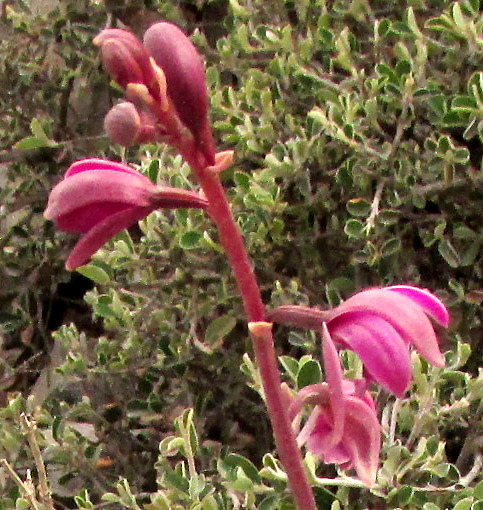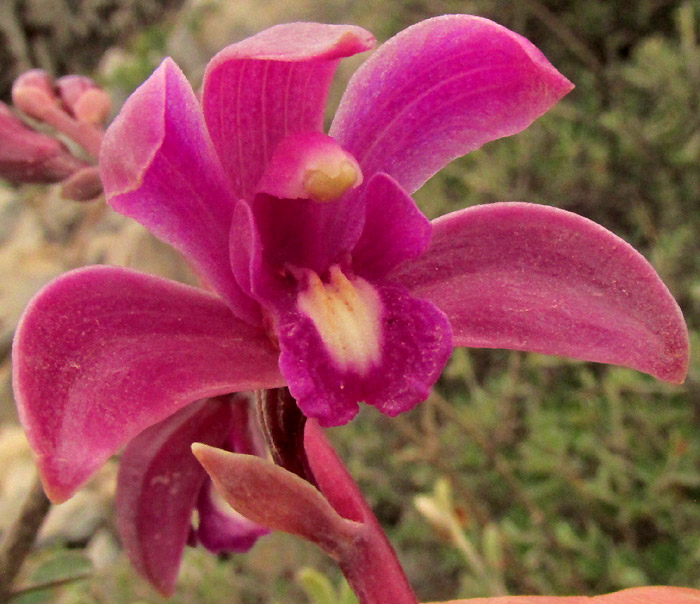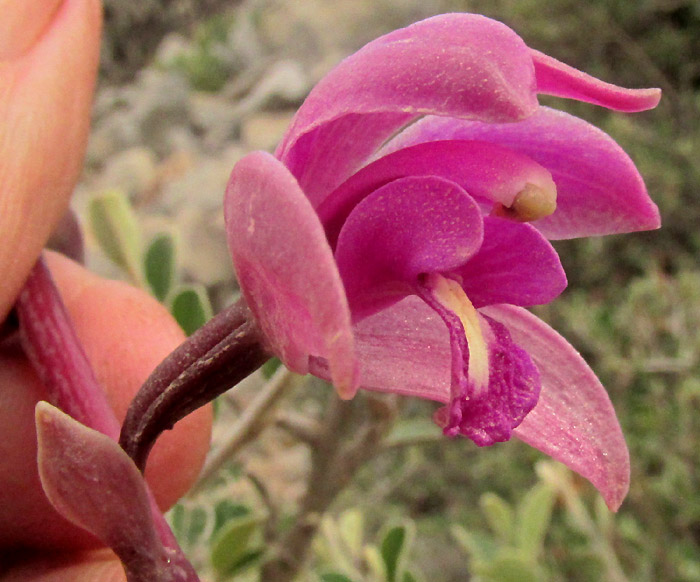Excerpts from Jim Conrad's
Naturalist Newsletter
Entry from field notes dated June 29, 2023, taken along roadside roadcut atop ridge forested largely of low-growing Quercus laeta, ridge rising on the southwestern side of Curva de la Doctorcilla, which is near km 18 on the branch road beginning at El Campamento and continuing to El Doctor, and which is numbered Hwy 120, though it branches off the main Hwy 120 running between San Juan del Río and Jalpan; limestone bedrock; elevation ~2930m (~9600 ft), Querétaro, MÉXICO, (N20.85971°, W99.60541°)
AUTUMN FLOWERING LAELIA, FLOWERING IN JUNE

The above shows the most surprising and disconcerting find of my week of camping in the area around El Doctor, every day looking for interesting finds. Clearly it's an orchid, just beginning to flower. I knew that probably it produced leaves and green, bulbous enlargements, or pseudobulbs, at the leaf bases, but they grew beneath a dense, continually wandering-livestock-pruned Southern False Serviceberry bush, as seen in the photo, and it would have taken a major, and destructive, effort to expose them. Besides, the flowers were so distinctive that surely the plant would be easy to identify. Also, the orchid and serviceberry occupied a pile of limestone tallus below a roadcut, and in such a disturbed habitat, surely it was a common, "weedy" species.

Only the lowest flower in the raceme was fully open, so this was the very beginning of its flowering period. Each flower and flower bud was subtended by a conspicuous scale, or bract, with pale, thin edges.

Typical of many orchid species, the flower's corolla produced three sepals and three petals. In this species all sepals and petals are fleshy and rose colored, and the sepals are slightly narrower than the petals. The lower petal is modified into a "lip," or labellum. In this species, the lip was three-lobed, the side lobes expanded into winglike appendages helping direct the pollinator toward the nectar.

The lip's white blotch attracts the pollinator's attention to the right spot, and the two ridge-like nectar guides further direct the visitor. The curved, petal-like appendage directly above the lip is the column, which is the orchid family's unique reproductive structure. This flower's petal-like column is tipped with a U-shaped, pale yellow anther, which produces packets of pollen destined to be transferred by pollinators. Unseen on the column below the anther is the stigma, which is a shallow, sticky cavity which receives pollen from other flowers; it's where fertilization takes place.
It can be hard to identify orchids. The Orchid Family, the Orchidaceae, currently comprises about 28,000 species distributed in around 763 genera, and new species regularly are recognized. All the above features led to the genus Laelia, a small genus of only about 25 species, naturally occurring only from Mexico south into South America, with the center of diversity here in Mexico. In the fine 1997 work by Federico Halbinger and Miguel Soto entitled "Laelias of Mexico," the authors suggest that "... an important aspect of the evolution of Laelia has been the occupation of progressively drier, cooler places with subtropical climate." Our plant in its very dry, high-elevation environment must feel at home.
The 2003 treatment of the genus Laelia in the Flora del Bajío dealing with plants of our semiarid, upland part of central Mexico documents four Laelia species in our region. With help of excellent photos and line drawings in the work by Halbinger and Soto, our plant's floral features reveal that here we have LAELIA AUTUMNALIS, often known as the Autumn Flowering Laelia. The species is endemic just to that part of Mexico in or near the Trans-Mexican Volcanic Belt cutting east-west across central Mexico.
The surprises and disconcerting features arise once the name is established and information is gathered around the name. First, both its English name and binomial declare the plant's autumn-flowering disposition, but our plant blossoms in June. Moreover, though this species is known to grow on the ground, mostly it's seen growing on tree branches, especially oaks, such as the Quercus laeta atop this ridge. Also, on the Internet, the vast majority of pictures of Laelia autumnalis portray corollas with different markings, and often of different hues. Moreover, we're on the northern extreme of this species' distribution; the 2003 Flora del Bajío wasn't aware of any plants growing here in Querétaro state. Finally, the literature places the uppermost elevation for Laelia autumnalis as 2700m (8860 ft), but here we are at ~2930m (~9600 ft). Maybe the June flowering and high elevation hang together.
For the above reasons, I hesitated to name this Laelia autumnalis, but the corolla structure simply belongs to that species. Besides, Halbinger & Soto describe the species as variable, manifesting at least three intergrading forms, plus they hybridize with other species. If you want to compare our flower's structure with that of other Laelia species, pay special attention to the anther shape, which is thickly U shaped on our plant, and the distance separating the ridged nectar guides on the lip.
The Flora del Bajío describes the species as "muy abundante," or very abundant, at least originally. Now Laelia autumnalis is so sought after and collected that the Flora defines the species as threatened. Traditionally, this plant has been collected for adorning altars during October's Day of the Dead festivals. The most commonly used Spanish name for the species seems to be Flor de los Muertos, Flower of the Dead.
Halbinger & Soto mention one more surprising feature, one shared by all Laelia species: That is, "No species produces nectar, nor any other type of reward, and the pollination is apparently of the deception type." Its looks and fragrance promise nectar, but none is provided; pollinators provide a service, but there's no payment. The authors also tell us that the pollinators are bumblebees of the genus Bombus, and that introduced European honey bees may frequently visit Laelia flowers, but they're too small to affect pollination.